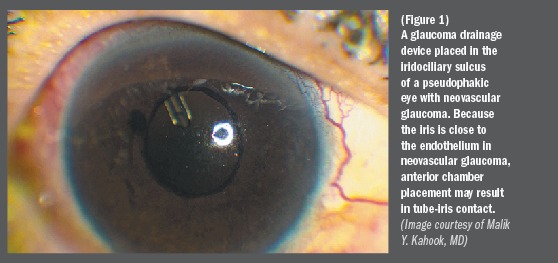Article
Strategies for the sulcus surgeon
The iridociliary sulcus is a hidden region of the eye that provides options for optimizing patient outcomes, particularly in patients with glaucoma.
Take-home
The iridociliary sulcus is a hidden region of the eye that provides options for optimizing patient outcomes, particularly in patients with glaucoma.

Dr. Kahook
The Glaucoma Angle By Nathan M. Radcliffe, MD
Editor’s Note: I would like to welcome readers to the return of The Glaucoma Angle presented by Ophthalmology Times. Richard K. Parrish II, MD, Bascom Palmer Eye Institute, University of Miami Miller School of Medicine, previously contributed to this column and I am honored to follow in his footsteps.
The primary focus of this regularly recurring column will be on the latest innovations in the medical and surgical treatment of glaucoma and anterior segment disease. Specialists from around the globe will also share their own pearls and practical knowledge to enhance patient care. My hope is that you can read the column today and implement the knowledge you learn in your clinics and operating rooms tomorrow. I welcome any input from you regarding the published columns and any advice for future topics of interest.
This month’s column provides surgical pearls from Nathan M. Radcliffe, MD. The iridociliary sulcus is a space that is not routinely accessed by the anterior segment surgeon. However, as readers will see, becoming familiar with this region of the eye will allow ophthalmologists to perform innovative procedures and to enhance outcomes in specific surgical scenarios.
-Malik Y. Kahook, MD

Dr. Radcliffe
The iridociliary sulcus-the space between the posterior surface of the iris and the anterior surface of the ciliary body or crystalline/IOL-is a part of the eyes anatomy that is rarely discussed.
Most cataract surgeons initially become familiar with the sulcus during the placement of a three-piece IOL in eyes that cannot support a single-piece lens within the capsule, but familiarity with this valuable part of eye anatomy should not end there. The sulcus can be a valuable area to place, or sew IOLs, but it can also be a valuable place to address glaucoma, allowing coagulative laser of the ciliary processes (endoscopic cyclophotocoagulation or ECP) to reduce IOP.
Endoscope invaluable
Most anterior segment surgeons that become comfortable with ECP will also find other uses for the endoscope when visualization of the sulcus is required. I have found the endoscope to be invaluable for visualizing the haptic of IOLs that have been placed in the sulcus in order to confirm ideal placement.
Placement of the tube from glaucoma drainage devices into the sulcus can protect the cornea from tube-shunt associated endothelial failure, usually performed in the pseudophakic eye. In patients with anterior chamber tubes and corneal decompensation, repositioning the tube into the sulcus may protect the cornea (or the new corneal graft) from further insult. While sulcus tube placement in phakic eyes carries risk of lens injury, it can safely be performed in patients with high peripheral anterior synechiae, such as eyes with neovascular glaucoma or patients with penetrating keratoplasty with iris adherent to the graft-host interface.

Working in the sulcus
One key principle of working in the sulcus is that if the surgeon is planning to place something there, the first step is to fill the sulcus with copious viscoelasticelastic, enough to cause the iris to bow forward toward the cornea.
The sulcus is also pathologically indicated in a few disease states, including plateau iris syndrome. In this condition, the sulcus is significantly reduced in size due to anterior positioning of the ciliary processes. During ECP, a cycloplasty can be performed by lasering the posterior ciliary processes, moving the ciliary processes posteriorly and opening up the sulcus and iridocorneal angle.
In addition to visualization with the endoscope, the sulcus can sometimes be visualized with gonioscopy (cycloscopy), which can be a great way to visualize a sulcus tube tip. When this is not possible, ultrasound biomicroscopy will allow visualization of the sulcus anatomy.
In summary, the iridociliary sulcus is a hidden region of the eye that provides options for optimizing patient outcomes, particularly in patients with glaucoma.
Malik Y. Kahook, MD, is editor of The Glaucoma Angle column. He is the Slater Family Endowed Chair in Ophthalmology, professor and vice chairman, clinical and translational research chief, Glaucoma Service, The University of Colorado School of Medicine, Aurora, CO. Readers may contact him at malik.kahook@gmail.com. He did not indicate any proprietary interest in the subject matter.
Nathan M. Radcliffe, MD, is assistant professor of ophthalmology at Weill Cornell Medical College and assistant attending ophthalmologist at New York-Presbyterian Hospital.Readers may reach Dr. Radcliffe at drradcliffe@gmail.com. He did not indicate any proprietary interest in the subject matter.
Newsletter
Don’t miss out—get Ophthalmology Times updates on the latest clinical advancements and expert interviews, straight to your inbox.




